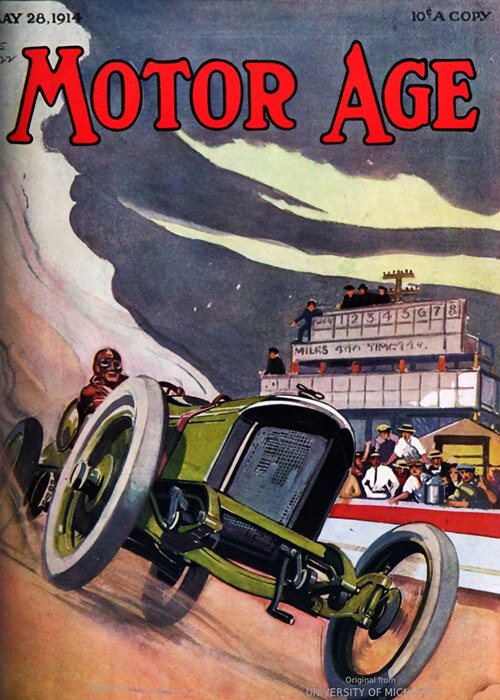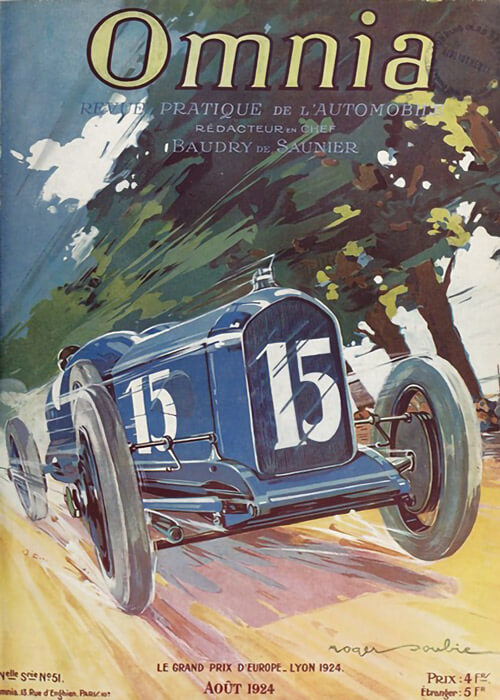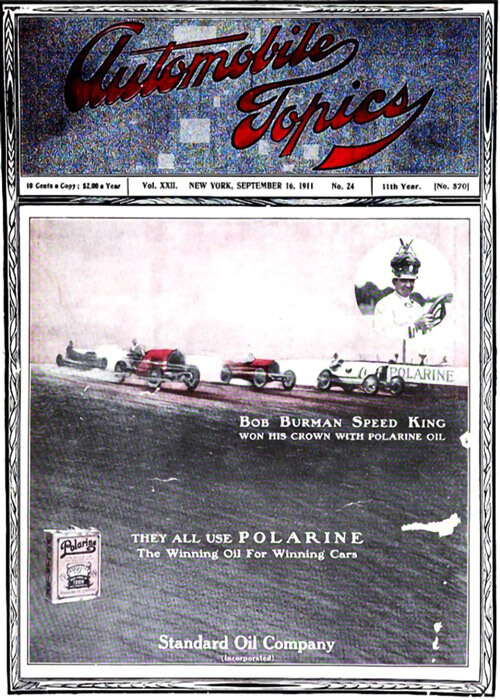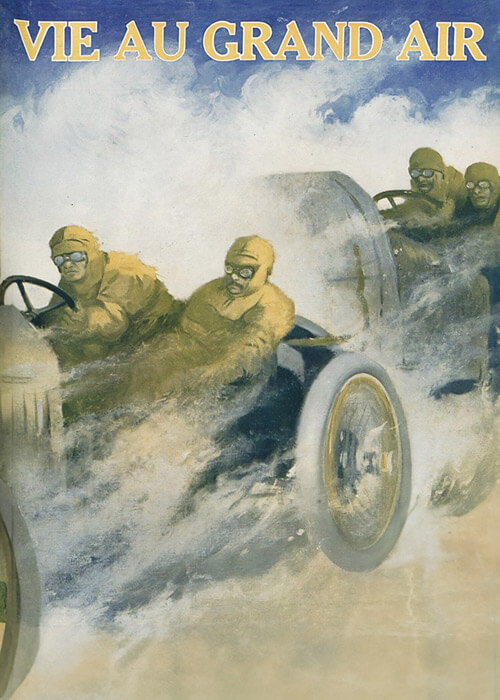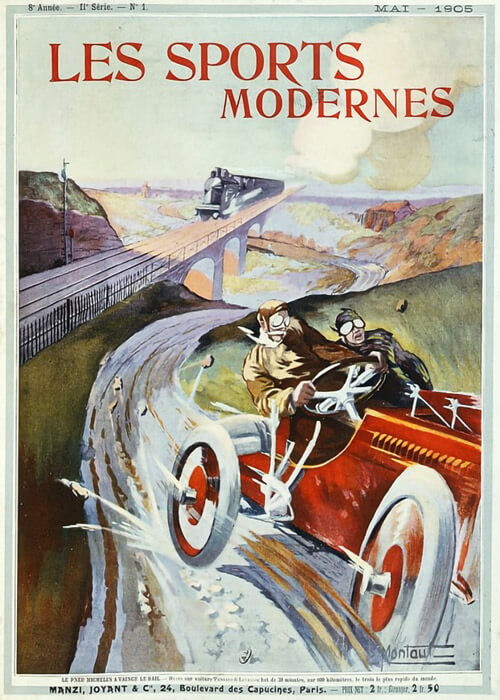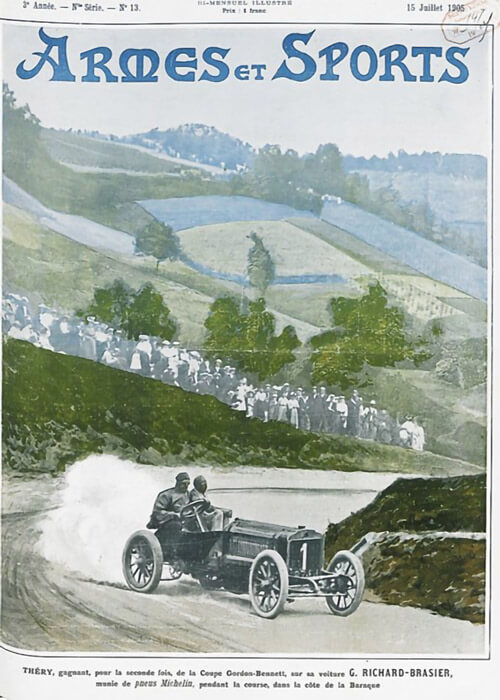This article in the Austrian Automobil-Zeitung is one of many more that would make a whole series of reports on the decision of the French ACF for the 1906 Grand Prix as replacement of the Gordon Bennett Cup series. Indeed, there was much protest to the French arguments, by most of the non-French automobile countries.
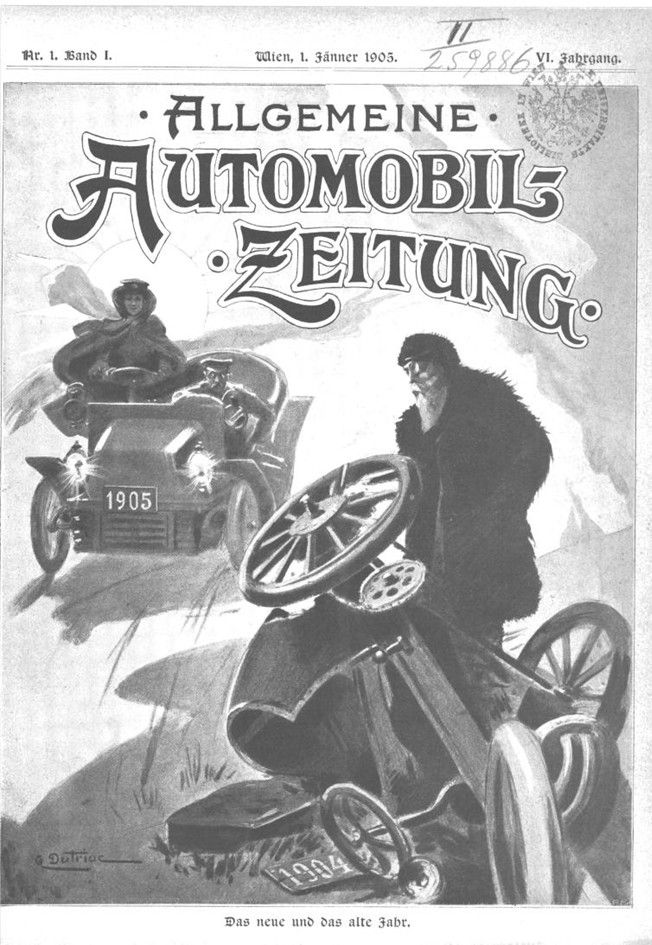
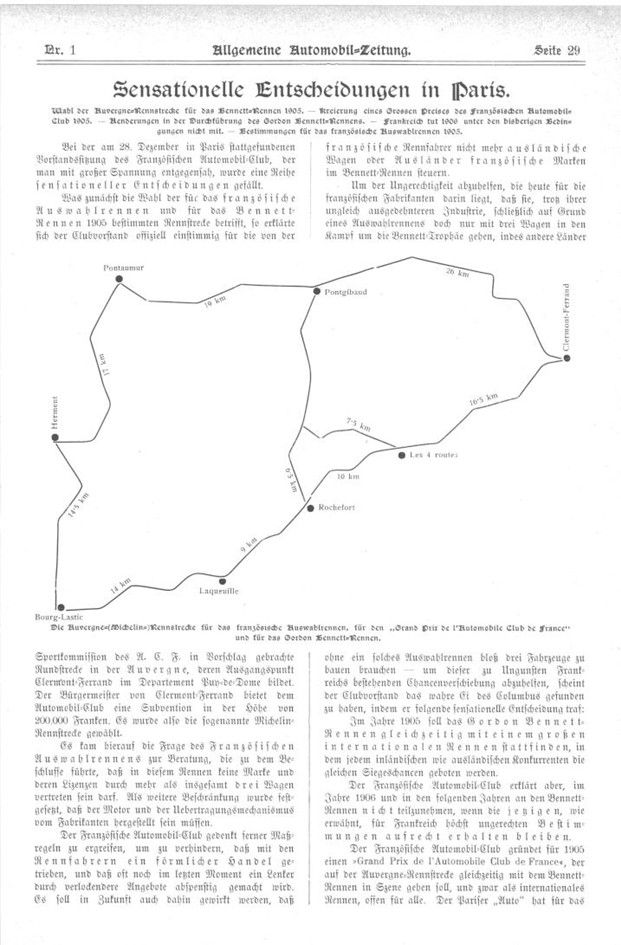
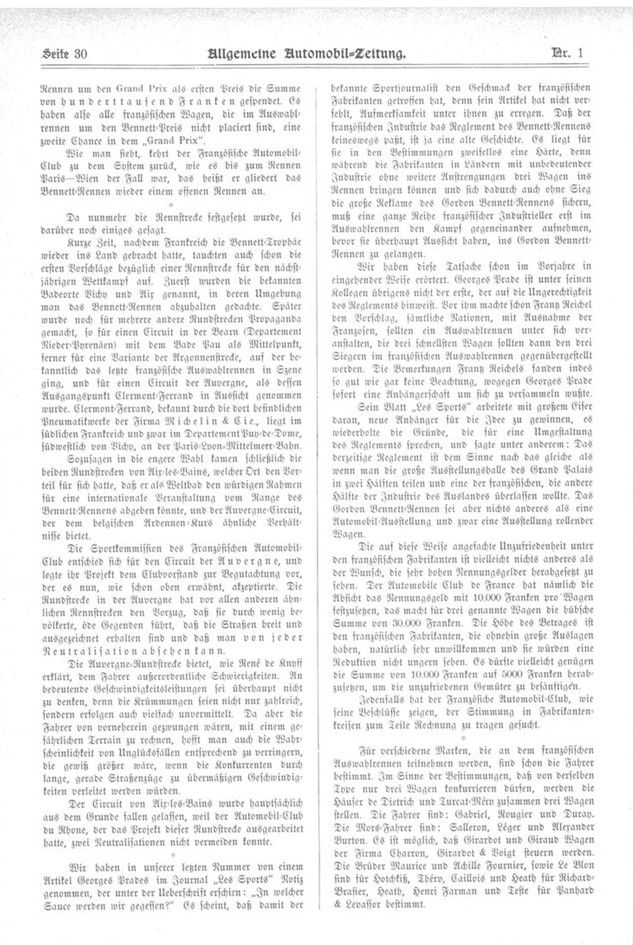
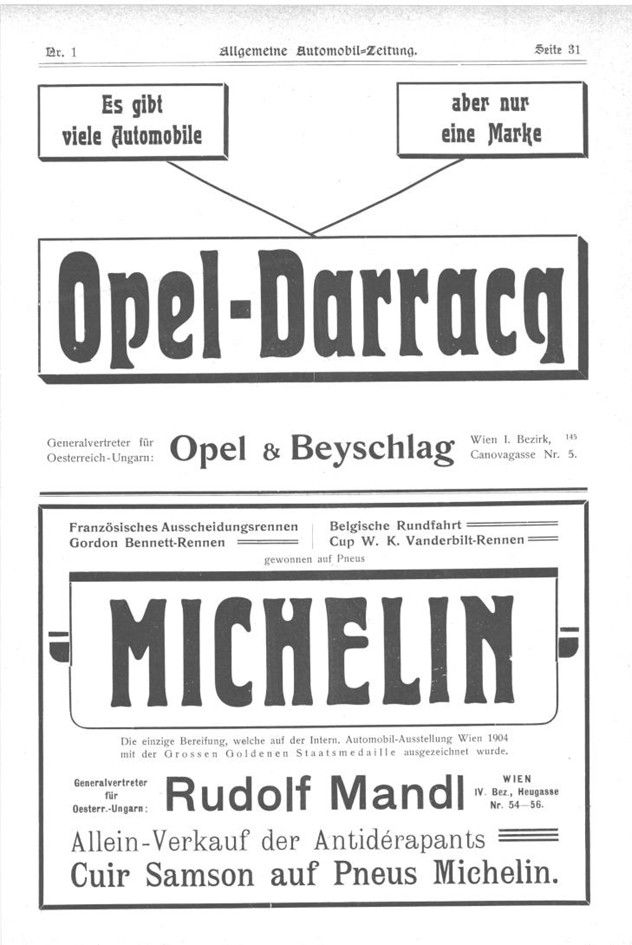
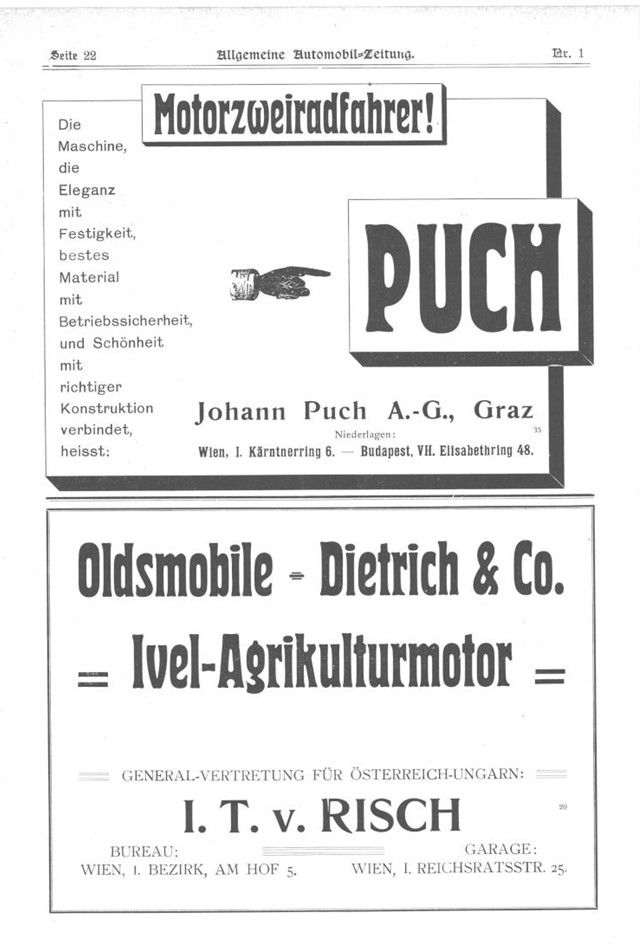
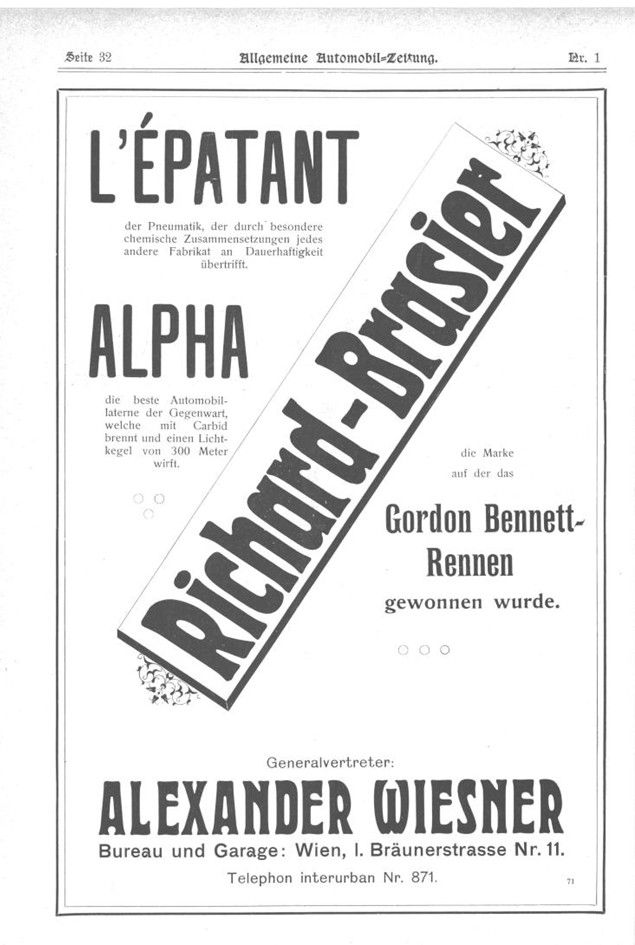
Text and jpegs by courtesy of Oesterreichische Nationalbibliothek, anno.ac.at; compiled by motorracinghistory.com
Allgemeine Automobil-Zeitung, VI. Jahrgang, Nr. 1, Band I, 1. Januar 1905, Seite 29 – 30
Sensationelle Entscheidungen in Paris.
Wahl der Auvergne=Rennstrecke für das Bennett=Rennen 1905.
Kreierung eines Großen Preises des französischen Automobil-Club 1905.
Änderungen in der Durchführung des Gordon Bennett=Rennens.
Frankreich tut 1906 unter den bisherigen Bedingungen nicht mit.
Bestimmungen für das französische Auswahlrennen 1905.
Bei der am 28. Dezember in Paris stattgefundenen Vorstandssitzung des französischen Automobil-Club, der man mit großer Spannung entgegensah, wurde eine Reihe sensationeller Entscheidungen gefällt.
Was zunächst die Wahl, der für das französische Auswahlrennen und für das Bennett=Rennen 1905 bestimmten Rennstrecke betrifft, so erklärte sich der Clubvorstand offiziell einstimmig für die von der Sportkommission des A. C. F. in Vorschlag gebrachte Rundstrecke in der Auvergne, deren Ausgangspunkt Clermont-Ferrand im Departement Puy-de-Dome bildet. Der Bürgermeister von Clermont-Ferrand bietet dem Automobil-Club eine Subvention in der Höhe von 200000 Franken. Es wurde also die sogenannte Michelin-Rennstrecke gewählt.
Es kam hieraus die Frage des französischen Auswahlrennens zur Beratung, die zu dem Beschlusse führte, dass in diesem Rennen keine Marke und deren Lizenzen durch mehr als insgesamt drei Wagen vertreten sein darf. Als weitere Beschränkung, wurde festgesetzt, dass der Motor und der Übertragungsmechanismus vom Fabrikanten hergestellt sein müssen.
Der französische Automobil-Club gedenkt ferner Maßregeln zu ergreifen, um zu verhindern, dass mit den Rennfahrern ein förmlicher Handel getrieben, und dass oft noch im letzten Moment ein Lenker durch verlockendere Angebote abspenstig gemacht wird. Es soll in Zukunft auch dahin gewirkt werden, dass französische Rennfahrer nicht mehr ausländische Wagen oder Ausländer französische Marken im Bennett=Rennen steuern.
Um der Ungerechtigkeit abzuhelfen, die heute für die französischen Fabrikanten darin liegt, dass sie, trotz ihrer ungleich ausgedehnteren Industrie schließlich auf Grund eines Auswahlrennens doch nur mit drei Wagen in den Kampf um die Bennett=Trophäe gehen, indes andere Länder ohne ein solches Auswahlrennen bloß drei Fahrzeuge zu bauen brauchen — — um dieser zu Ungunsten Frankreichs bestehenden Chancenverschiebung abzuhelfen, scheint der Clubvorstand das wahre Ei des Columbus gesunden zu haben, indem er folgende sensationelle Entscheidung traf:
Im Jahre 1905 soll das Gordon Bennett-Rennen gleichzeitig mit einem großen internationalen Rennen stattfinden, in dem jedem inländischen wie ausländischen Konkurrenten die gleichen Siegeschancen geboten werden.
Der französische Automobil-Club erklärt aber, im Jahre 1906 und in den folgenden Jahren an den Bennett-Rennen nicht teilzunehmen, wenn die jetzigen, wie erwähnt, für Frankreich höchst ungerechten Bestimmungen aufrecht erhalten bleiben.
Der französische Automobil-Club gründet für 1905 einen „Grand Prix de l‘Automobile Club de France“, der aus der Auvergne-Rennstrecke gleichzeitig mit dem Bennett-Rennen in Szene gehen soll, und zwar als internationales Rennen, offen für alle. Der Pariser »Auto« hat für das Rennen um den Grand Prix als ersten Preis die Summe von hunderttausend Franken gespendet. Es haben also alle französischen Wagen, die im Auswahlrennen um den Bennett-Preis nicht platziert sind, eine zweite Chance in dem »Grand Prix«.
Wie man sieht, kehrt der Französische Automobil-Club zu dem System zurück, wie es bis zum Rennen Paris—Wien der Fall war, das heißt er gliedert das Bennett-Rennen wieder einem offenen Rennen an.
* * *
Da nunmehr die Rennstrecke festgesetzt wurde, sei darüber noch einiges gesagt.
Kurze Zeit, nachdem Frankreich die Bennett-Trophäe wieder ins Land gebracht hatte, tauchten auch schon die ersten Vorschläge bezüglich einer Rennstrecke für den nächstjährigen Wettkampf auf. Zuerst wurden die bekannten Badeorte Vichy und Aix genannt, in deren Umgebung man das Bennett-Rennen abzuhalten gedachte. Später wurde noch für mehrere andere Rundstrecken Propaganda gemacht, so für einen Circuit in der Bearn (Departement Nieder-Pyrenäen) mit dem Bade Pau als Mittelpunkt, ferner für eine Variante der Argonnenstrecke, auf der bekanntlich das letzte französische Auswahlrennen in Szene ging, und für einen Circuit der Auvergne, als dessen Ausgangspunkt Clermont-Ferrand in Aussicht genommen wurde. Clermont-Ferrand, bekannt durch die dort befindlichen Pneumatikwerke der Firma Michelin & Cie., liegt im südlichen Frankreich, und zwar im Departement Puy-de-Dome, südwestlich von Vichy, an der Paris-Lyon-Mittelmeer-Bahn.
Sozusagen in die engere Wahl kamen schließlich die beiden Rundstrecken von Aix-les-Bains, welcher Ort den Vorteil für sich hatte, dass er als Weltbad den würdigen Rahmen für eine internationale Veranstaltung vom Range des Bennett-Rennens abgeben könnte, und der Auvergne-Circuit, der dem belgischen Ardennen-Kurs ähnliche Verhältnisse bietet.
Die Sportkommission des französischen Automobil-Club entschied sich für den Circuit der Auvergne, und legte ihr Projekt dem Clubvorstand zur Begutachtung vor, der es nun, wie schon oben erwähnt, akzeptierte. Die Rundstrecke in der Auvergne hat vor allen anderen ähnlichen Rennstrecken den Vorzug, dass sie durch wenig bevölkerte, öde Gegenden führt, dass die Straßen breit und ausgezeichnet erhalten sind und dass man von jeder Neutralisation absehen kann.
Die Auvergne-Rundstrecke bietet, wie Rene de Knyff erklärt, dem Fahrer außerordentliche Schwierigkeiten. An bedeutende Geschwindigkeitsleistungen sei überhaupt nicht zu denken, denn die Krümmungen feien nicht nur zahlreich, sondern erfolgen auch vielfach unvermittelt. Da aber die Fahrer von vorneherein gezwungen wären, mit einem gefährlichen Terrain zu rechnen, hofft man auch die Wahrscheinlichkeit von Unglücksfällen entsprechend zu verringern, die gewiss größer wäre, wenn die Konkurrenten durch lange, gerade Straßenzüge zu übermäßigen Geschwindigkeiten verleitet werden würden.
Der Circuit von Aix-les-Bains wurde hauptsächlich aus dem Grunde fallen gelassen, weil der Automobil-Club du Rhone, der das Projekt dieser Rundstrecke ausgearbeitet hatte, zwei Neutralisationen nicht vermeiden konnte.
* * *
Wir haben in unserer letzten Nummer von einem Artikel Georges Prades im Journal »Les Sports« Notiz genommen, der unter der Überschrift erschien: »In welcher Sauce werden wir gegessen?« Es scheint, dass damit der bekannte Sportjournalist den Geschmack der französischen Fabrikanten getroffen hat, denn sein Artikel hat nicht verfehlt, Aufmerksamkeit unter ihnen zu erregen. Dass der französischen Industrie das Reglement des Bennett-Rennens keineswegs passt, ist ja eine alte Geschichte. Es liegt für sich in den Bestimmungen zweifellos eine Härte, denn während die Fabrikanten in Ländern mit unbedeutender Industrie ohne weitere Anstrengungen drei Wagen ins Rennen bringen können und sich dadurch auch ohne Sieg die große Reklame des Gordon Bennett-Rennens sichern, muss eine ganze Reihe französischer Industrieller erst im Auswahlrennen den Kampf gegeneinander aufnehmen, bevor sie überhaupt Aussicht haben, ins Gordon Bennett-Rennen zu gelangen.
Wir haben diese Tatsache schon in den Vorjahren in eingehender Weise erörtert. Georges Prade ist unter seinen Kollegen übrigens nicht der erste, der auf die Ungerechtigkeit des Reglements hinweist. Vor ihm machte schon Franz Reichels den Vorschlag, sämtliche Nationen, mit Ausnahme der Franzosen, sollten ein Auswahlrennen unter sich veranstalten, die drei schnellsten Wagen sollten dann den drei Siegern im französischen Auswahlrennen gegenübergestellt werden. Die Bemerkungen Frantz Reichels fanden indes so gut wie gar keine Beachtung, wogegen Georges Prade sofort eine Anhängerschaft, um sich zu versammeln wusste.
Sein Blatt ,,Les Sports« arbeitete mit großem Eifer daran, neue Anhänger für die Idee zu gewinnen, es wiederholte die Gründe, die für eine Umgestaltung des Reglements sprechen, und sagte unter anderem: Das derzeitige Reglement ist dem Sinne nach das gleiche als wenn man die große Ausstellungshalle des Grand Palais in zwei Hälften teilen und eine der französischen, die andere Hälfte der Industrie des Auslandes überlassen wollte. Das Gordon Bennett-Rennen sei aber nichts anderes als eine Automobil-Ausstellung, und zwar eine Ausstellung rollender Wagen.
Die auf diese Weise angefachte Unzufriedenheit unter den französischen Fabrikanten ist vielleicht nichts anderes als der Wunsch, die sehr hohen Nennungsgelder herabgesetzt zu sehen. Der Automobile Club de France hat nämlich die Absicht das Nennungsgeld mit 10.000 Franken pro Wagen festzusetzen, das macht für drei genannte Wagen die hübsche Summe von 30.000 Franken. Die Höhe des Betrages ist den französischen Fabrikanten, die ohnehin große Auslagen haben, natürlich sehr unwillkommen und sie würden eine Reduktion nicht ungern sehen. Es dürfte vielleicht genügen die Summe von 10.000 Franken auf 5000 Franken herabzusetzen, um die unzufriedenen Gemüter zu besänftigen.
Jedenfalls hat der Französiche Automobil-Club, wie seine Beschlüsse zeigen, der Stimmung in Fabrikantenkreisen zum Teile Rechnung zu tragen gesucht.
* * *
Für verschiedene Marken, die an dem französischen Auswahlrennen teilnehmen werden, sind schon die Fahrer bestimmt. Im Sinne der Bestimmungen, dass von derselben Type nur drei Wagen konkurrieren dürfen, werden die Häuser de Dietrich und Turcat-Merv zusammen drei Wagen stellen. Die Fahrer sind: Gabriel, Rougier und Duray. Die Mors-Fahrer sind: Salleron, Leger und Alexander Burton. Es ist möglich, dass Girardot und Giraud Wagen der Firma Charron, Girardot & Voigt steuern werden. Die Brüder Maurice und Achille Fournier, sowie Le Blon sind für Hotchkiss, Thery, Caillois und Heath für Richard-Brasier, Heath, Henri Farman und Teste für Panhard & Levassor bestimmt.
Translation by DeepL.com
Sensational decisions in Paris.
Choice of the Auvergne circuit for the Bennett race in 1905.
Creation of a French Automobile Club Grand Prix in 1905.
Changes to the Gordon Bennett race.
France will not participate in 1906 under the previous conditions.
Regulations for the French selection race in 1905.
At the long-awaited board meeting of the French Automobile Club held in Paris on December 28, a series of sensational decisions were made.
With regard to the choice of the racetrack for the French eliminaton race and the Bennett race in 1905, the club’s board of directors officially and unanimously approved the circular route in the Auvergne, proposed by the A.C.F.’s sports commission, with the starting point in Clermont-Ferrand in the Puy-de-Dome department. The mayor of Clermont-Ferrand offered the automobile club a subsidy of 200,000 francs. So the so-called Michelin circuit was chosen.
This raised the question of the French selection race, which led to the decision that no brand and its licenses may be represented by more than three cars in this race. As a further restriction, it was determined that the engine and transmission mechanism must be manufactured by the manufacturer.
The French Automobile Club also intends to take measures to prevent drivers from being formally traded and from being tempted by more enticing offers at the last moment. In the future, it should also be ensured that French racing drivers no longer drive foreign cars or that foreigners drive French brands in the Bennett race.
To remedy the injustice that currently exists for French manufacturers in that, despite their incomparably more extensive industry, ultimately only enter the race for the Bennett trophy with three cars due to the selection race, while other countries without such a selection race only need to build three vehicles – – in order to remedy this imbalance of opportunities to the disadvantage of France, the club board seems to have come up with the real egg of Columbus by making the following sensational decision:
In 1905, the Gordon Bennett race is to take place at the same time as a major international race in which every domestic and foreign competitor will be offered the same chance of victory.
However, the French Automobile Club has declared that it will not take part in the Bennett race in 1906 and subsequent years if the current regulations, which are highly unfair to France, are maintained.
The French Automobile Club is founding a “Grand Prix de l’Automobile Club de France” for 1905, which is to take place on the Auvergne race track at the same time as the Bennett race, as an international race open to all. The Parisian magazine “Auto” has donated the sum of one hundred thousand francs as the first prize for the race for the Grand Prix. Thus, all French cars that did not place in the Bennett Prize race will have a second chance in the “Grand Prix”.
As can be seen, the French Automobile Club is returning to the system that was in place until the Paris-Vienna race, that is, it is once again adding the Bennett race to an open race.
* * *
Now that the race route has been determined, a few more words should be said about it.
Shortly after France brought the Bennett Trophy back into the country, the first suggestions regarding a race route for next year’s competition emerged. At first, the well-known resort towns of Vichy and Aix were mentioned, in whose vicinity the Bennett race was thought to be held. Later, propaganda was made for several other circuits, such as a circuit in the Bearn (department of Lower Pyrenees) with the spa town of Pau as its center, as well as for a variant of the Argonne route, on which, as is well known, the last French selection race took place, and for a circuit in the Auvergne, with Clermont-Ferrand as its starting point. Clermont-Ferrand, known for the Michelin & Cie. pneumatic tire factory located there, is situated in the south of France, in the department of Puy-de-Dome, southwest of Vichy, on the Paris-Lyon-Mediterranean railway.
The two circuits of Aix-les-Bains, which had the advantage of being a world-class spa town that could provide a worthy setting for an international event of the calibre of the Bennett race, and the Auvergne circuit, which offers conditions similar to the Belgian Ardennes circuit, were shortlisted, so to speak.
The sports commission of the French Automobile Club opted for the Auvergne circuit and submitted its project to the club’s board of directors for approval, which, as mentioned above, it has now received. The circuit in the Auvergne has the advantage over all other similar racetracks in that it passes through sparsely populated, desolate areas, the roads are wide and in excellent condition, and there is no need for neutralization.
As Rene de Knyff explains, the Auvergne circuit presents the driver with extraordinary difficulties. Significant speed achievements are out of the question, because the bends are not only numerous, but also often occur suddenly. But since the drivers would be forced to expect dangerous terrain from the outset, it is also hoped that the probability of accidents will be reduced accordingly, which would certainly be greater if the competitors were tempted to drive at excessive speeds by long, straight stretches of road.
The circuit of Aix-les-Bains was dropped mainly because the Automobile Club du Rhone, which had developed the project for this circuit, was unable to avoid two neutralizations.
* * *
In our last issue, we reported on an article by Georges Prades in the journal “Les Sports” entitled “ in which sauce we are eaten in?” It seems that the well-known sports journalist has hit the taste of the French manufacturers with this, because his article has not failed to attract attention among them. It is an old story that the regulations of the Bennett race do not suit French industry at all. There is undoubtedly an inherent harshness in the regulations, because while manufacturers in countries with insignificant industry can enter three cars in the race without further effort and thus secure the great publicity of the Gordon Bennett race even without winning, a whole series of French industrialists must first compete against each other in the selection race before they even have a chance of entering the Gordon Bennett race.
We have discussed this fact in detail in previous years. Incidentally, Georges Prade is not the first among his colleagues to point out the injustice of the regulations. Before him, Franz Reichels had already suggested that all nations, except the French, should hold a selection race among themselves, with the three fastest cars then being pitted against the three winners in the French selection race. Frantz Reichels‘ comments, however, were largely ignored, whereas Georges Prade immediately managed to gather a following around him.
His newspaper “Les Sports” worked with great zeal to win new supporters for the idea, repeating the reasons that spoke in favor of a change in the regulations, and saying, among other things: The current regulations are the same in spirit as if one wanted to divide the large exhibition hall of the Grand Palais into two halves and leave one half to the French and the other half to industry from abroad. The Gordon Bennett race, however, is nothing more than an automobile exhibition, and specifically an exhibition of rolling cars.
The discontent among French manufacturers that has been stirred up in this way is perhaps nothing more than the desire to see the very high entry fees reduced. The Automobile Club de France intends to set the entry fee at 10,000 francs per car, which makes a tidy sum of 30,000 francs for three cars. The amount is, of course, very unwelcome to the French manufacturers, who have large expenses anyway, and they would not be unhappy to see a reduction. It might be enough to lower the sum from 10,000 francs to 5,000 francs to appease the disgruntled.
In any case, the French Automobile Club, as its resolutions show, has tried to take into account the mood in manufacturing circles to some extent.
* * *
The drivers have already been determined for various brands that will take part in the French selection race. In accordance with the rule that only three cars of the same type may compete, the de Dietrich and Turcat-Merv companies will enter three cars. The drivers are: Gabriel, Rougier and Duray. The Mors drivers are: Salleron, Leger and Alexander Burton. It is possible that Girardot and Giraud will drive cars from the Charron company, Girardot & Voigt. The brothers Maurice and Achille Fournier, as well as Le Blon, are destined for Hotchkiss, Thery, Caillois and Heath for Richard-Brasier, Heath, Henri Farman and Teste for Panhard & Levassor.
Page 29.
The Auvergne=(Michelin) race track for the French selection race for the “Grand Prix de l’Automobile Club de France” and for the Gordon Bennett race.
